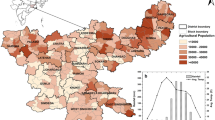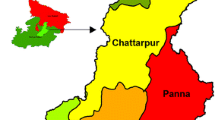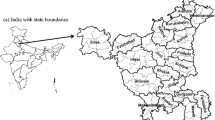Abstract
The study presents a methodology to assess and map agricultural drought vulnerability during main kharif crop season at local scale and compare its intra-seasonal variations. A conceptual model of vulnerability based on variables of exposure, sensitivity, and adaptive capacity was adopted, and spatial datasets of key biophysical factors contributing to vulnerability were generated using remote sensing and GIS for Rajasthan State of India. Hazard exposure was based on frequency and intensity of gridded standardized precipitation index (SPI). Agricultural sensitivity was based on soil water holding capacity as well as on frequency and intensity of normalized difference vegetation index (NDVI)-derived trend adjusted vegetation condition index (VCITadj). Percent irrigated area was used as a measure of adaptive capacity. Agricultural drought vulnerability was derived separately for early, mid, late, and whole kharif seasons by composting rating of factors using linear weighting scheme and pairwise comparison of multi-criteria evaluation. The regions showing very low to extreme rating of hazard exposure, drought sensitivity, and agricultural vulnerability were identified at all four time scales. The results indicate that high to extreme vulnerability occurs in more than 50 % of net sown area in the state and such areas mostly occur in western, central, and southern parts. The higher vulnerability is on account of non-irrigated croplands, moderate to low water holding capacity of sandy soils, resulting in higher sensitivity, and located in regions with high probability of rainfall deficiency. The mid and late season vulnerability has been found to be much higher than that during early and whole season. Significant correlation of vulnerability rating with food grain productivity, drought recurrence period, crop area damaged in year 2009 and socioeconomic indicator of human development index (HDI) proves the general soundness of methodology. Replication of this methodology in other areas is expected to lead to better preparedness and mitigation-oriented management of droughts.










Similar content being viewed by others
References
Blaikie, P., Cannon, T., Davis, I., & Wisner, B. (1994). At risk: natural hazards, people’s vulnerability, and disasters. London: Routledge Publisher.
Bohle, H. G., Downing, T. E., & Watts, M. J. (1994). Climate change and social vulnerability—toward a sociology and geography of food insecurity. Global Environment Change, 4(1), 37–48.
Brooks, N., Adger, W. N., & Kelly, P. M. (2005). The determinants of vulnerability and adaptive capacity at the national level and the implications for adaptation. Global Environment Change-Human and Policy Dimensions, 15(2), 151–163.
Chambers, R. (1989). Vulnerability, coping and policy—introduction. IDS Bulletin-Institute of Development Studies, 20(2), 1–7.
Cutter, S. L., Boruff, B. F., & Shirley, W. L. (2003). Social vulnerability to environmental hazards. Social Science Quarterly, 84(2), 242–261.
De Jager, J. M., Howard, M. D., & Fouche, H. J. (1997). Computing drought severity and forecasting its future impact on grazing in a GIS. In D. A. Wilhite (Ed.), Hazards and disaster: a series of definite works. U.K.: Routledge Publishers.
Dhakar, R., Sehgal, V. K., & Pradhan, S. (2013). Study on inter-seasonal and intra-seasonal relationships of meteorological and agricultural drought indices in the Rajasthan State of India. Journal of Arid Environments, 97, 108–119.
Downing, T. E., & Bakker, K. (2000). Drought discourse and vulnerability. In D. A. Wilhite (Ed.), Drought: a global assessment. Natural hazards and disasters series. U.K.: Routledge Publishers.
Downing, T. E., Butterfield, R., Cohen, S., Huq, S., Moss, R., Rahman, A., & Sokona, Y., Stephen, L. (2001). Vulnerability indices: climate change impacts and adaptation. United Nations Environment Programme, Policy Series, 3.
Eastman, J. R., Jin, W., Kyem, P. A. K., & Toledano, J. (1995). Raster procedure for multicriteria/multiobjective decisions. Photogrammetric Engineering and Remote Sensing, 61(5), 539–547.
Eastman, J. R., Emani, S., Hulina, S., Jiang, H., Johnson, A., & Ramachandran, M. (1997). Application of geographic information systems (GIS) technology in environmental risk assessment and management. Worcester: Idrisi Project, Clark University.
Fontaine, M. M., & Steinemann, A. C. (2009). Assessing vulnerability to natural hazards: impact-based method and application to drought in Washington State. Natural Hazards Review, 10(1), 11–17.
Ghosh, T. K. (1997). Investigation of drought through digital analysis of satellite data and geographical information systems. Theoretical and Applied Climatology, 58, 105–112.
Hayes, M. J., Wilhelmi, O. V., & Kautson, C. L. (2004). Reducing drought risk: bridging theory and practice. Natural Hazards Review, 5(2), 106–113.
Hewitt, K. (1997). Regions at risk. A geographical introduction to disasters. England: Addison Wesley Longman Limited.
IPCC. (2014). In V. R. Barros, C. B. Field, D. J. Dokken, M. D. Mastrandrea, K. J. Mach, T. E. Bilir, M. Chatterjee, K. L. Ebi, Y. O. Estrada, R. C. Genova, B. Girma, E. S. Kissel, A. N. Levy, S. MacCracken, P. R. Mastrandrea, & L. L. White (Eds.), Climate change 2014: impacts, adaptation, and vulnerability. Part B: regional aspects. Contribution of Working Group II to the Fifth Assessment Report of the Intergovernmental Panel on Climate Change. Cambridge: Cambridge University Press. 688 pp.
Jackson, C. I. (1991). Response strategies for the great plains: Canadian and U.S. perspectives. In G. Wall (Ed.), Symposium on the Impacts of Climatic Change and Variability on the Great Plains, Department of Geography Publication Series, Occasional Paper No. 12 (pp. 93–103). University of Waterloo.
Ji, L., & Peters, A. J. (2003). Assessing vegetation response to drought in the northern Great Plains using vegetation and drought indices. Remote Sensing of Environment, 87, 85–98.
Jonsson, P., & Eklundh, L. (2004). TIMESAT—a program for analyzing time-series of satellite sensor data. Computer & Geoscience, 30, 833–845.
Kasperson, R. (2001). Vulnerability and global environmental change. International Human Dimensions Program Update, 01(2), 2–3.
Kates, R. W. (1985). The interaction of climate and society. In R. W. Kates, J. H. Ausubel, & M. Berbarian (Eds.), Climate impacts assessment (pp. 3–36). Chichester: John Wiley.
Keenan, S. P., & Krannich, R. S. (1997). The social context of perceived drought vulnerability. Rural Sociology, 62(1), 69–88.
Keyantash, J., & Dracup, J. A. (2002). The quantification of drought: an evaluation of drought indices. Bulletin of American Meteorological Society, 83(8), 1167–1180.
Klein, R. J. T., & Maciver, D. C. (1999). Adaptation to climate variability and change: methodological issues. Mitigation and Adaptation Strategies for Global Change, 4, 189–198.
Klein, R. J. T., Nicholls, R. J., & Mimura, N. (1999). Coastal adaptation to climate change: can the IPCC technical guidelines be applied? Mitigation and Adaptation Strategies for Global Change, 4, 239–252.
Kogan, F. N. (1995). Droughts of the late 1980s in the United States as derived from NOAA polar orbiting satellite data. Bulletin of the American Meteorological Society, 76(5), 655–668.
Matthews, K. B., MacDonald, A., Aspinall, R. J., Hudson, G., Law, A. N. R., & Paterson, E. (1994). Climatic soil moisture deficit—climate and soil data integration in a GIS. Climatic Change, 28, 273–287.
McKee, T. B., Doesken, N. J., & Kleist, J. (1993). The relationship of drought frequency and duration to time scales. In Proc. 8th conference on applied climatology (pp. 179–184) Anaheim
Mitchell, T. D., & Jones, P. D. (2005). An improved method of constructing a database of monthly climate observations and associated high-resolution grids. International Journal of Climate, 25, 693–712.
Murthy, et al. (2015). A study on agricultural drought vulnerability at disaggregated level in a highly irrigated and intensely cropped state of India. Environment Monitoring Assessment, 187, 140–153.
New, M., Hulme, M., & Jones, P. D. (2000). Representing twentieth century space–time climate variability. Part 2: development of 1901–96 monthly grids of terrestrial surface climate. Journal of Climate, 13, 2217–2238.
Opie, J. (1989). 100 years of climate risk assessment on the High Plains: which farm paradigm does irrigation serve? Agricultural History, 63, 243–269.
Prathumchai, K., Honda, K., & Nualchawee, K. (2001). Drought risk evaluation using remote sensing and GIS: a case study in Lop Buri Province. 22nd Asian Conference on Remote Sensing, 5–9 November 2001, Singapore.
Reed, B. C. (1993). Using remote sensing and geographic information systems for analyzing landscape/drought interaction. International Journal of Remote Sensing, 14(18), 3489–3503.
Ribot, J. C. (1996). Climate variability, climate change and vulnerability: moving forward by looking back. In J. C. Ribot, A. R. Magalhães, & S. S. Panagides (Eds.), Climate variability, climate change and social vulnerability in the semi-arid tropics. New York: Cambridge University Press.
Saaty, T. L. (1977). A scaling method for priorities in hierarchical structures. Journal of Mathematical Psychology, 15, 234–281.
Saaty, T. L. (1980). The analytic hierarchy process (pp. 20–25). New York: McGraw-Hill International.
Schroter, D., Polsky, C., & Patt, A. G. (2005). Assessing vulnerabilities to the effects of global change: an eight step approach. Mitigation and Adaptation Strategies for Global Change, 10, 573–596.
Shahid, S., & Behrawan, H. (2008). Drought risk assessment in the western part of Bangladesh. Natural Hazards, 46, 391–413.
Siebert, S., Doll, P., Hoogeveen, J., Faures, J. M., Frenken, K., & Feick, S. (2005). Development and validation of the global map of irrigation areas. Hydrology and Earth System Science, 9, 535–547.
Siebert, S., Doll, P., Feick, S., Hoogeveen, J., & Frenken, K. (2007). Global map of irrigation areas version 4.0.1. Rome: Johann Wolfgang Goethe University, Frankfurt am Main, Germany/Food and Agriculture Organization of the United Nations.
Slejko, M., Gregoric, G., & Bergant, K. (2009). Drought vulnerability assessment for the agriculture: a case study for the west part of Slovenia. Geophysical Research Abstract, 11, EGU2009-2791, EGU General Assembly 2009.
Smit, B., Burton, I., Klein, R. J. T., & Street, R. (1999). The science of adaptation: a framework for assessment. Mitigation and Adaptation Strategies for Global Change, 4(3,4), 199–213.
Srinivasarao, C., Venkateswarlu, B., Sikka, A. K., Prasad, Y. G., Chary, G. R., Rao, K. V., Gopinath, K. A., Osman, M., Ramana, D. B. V., Maheswari, M., & Rao, V. U. M. (2015). District agriculture contingency plans to address weather aberrations and for sustainable food security in India. Hyderabad: ICAR-Central Research Institute for Dryland Agriculture, Natural Resource Management Division. 22 p.
Turner, B. L., Kasperson, R. E., Matson, P. A., McCarthy, J. J., Corell, R. W., Christensen, L., Eckley, N., Kasperson, J. X., Luers, A., Martello, M. L., Polsky, C., Pulsipher, A., & Schiller, A. (2003). A framework for vulnerability analysis in sustainability science. Proceedings of the National Academy of Sciences of the United States of America, 100(14), 8074–8079.
UNDP (2009). Human development report. Retrieved from http://hdr.undp.org/en/reports/global/hdr2009/.
Voogd, H. (1983). Multicriteria evaluation for urban and regional planning. London: Pion Ltd.
Walker, B., Carpenter, S., Anderies, J., Abel, N., Cummings, G., Janssen, M., Lebel, L., Norberg, J., Peterson, G. D., & Pritchard, R. (2002). Resilience management in social-ecological systems: a working hypothesis for a participatory approach. Conservation Ecology, 6(1), 14.
Wilhelmi, O. V., & Wilhite, D. A. (2002). Assessing vulnerability to agricultural drought: a Nebraska case study. Natural Hazards, 25(1), 37–58.
Wilhite, D. A. (2000). Drought as a natural hazard: concepts and definitions. Chapter 1. In D. A. Wilhite (Ed.), Drought: a global assessment, natural hazards and disasters series. UK: Routledge Publishers.
Wu, H., & Wilhite, D. A. (2004). An operational agricultural drought risk assessment model for Nebraska, USA. Natural Hazards, 33(1), 1–21.
Acknowledgments
The second author gratefully acknowledges the junior research fellowship received from the Indian Council of Agricultural Research (ICAR), New Delhi to undertake this study. This study was supported by in-house project grant code IARI:PHY:09:04(3) of Indian Agricultural Research Institute. The authors also thank the two reviewers in suggesting improvement in the manuscript.
Author information
Authors and Affiliations
Corresponding author
Rights and permissions
About this article
Cite this article
Sehgal, V.K., Dhakar, R. Geospatial approach for assessment of biophysical vulnerability to agricultural drought and its intra-seasonal variations. Environ Monit Assess 188, 197 (2016). https://doi.org/10.1007/s10661-016-5187-5
Received:
Accepted:
Published:
DOI: https://doi.org/10.1007/s10661-016-5187-5




